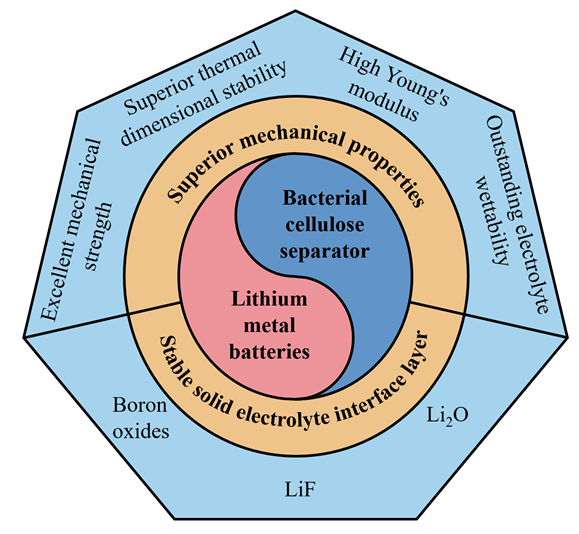| [1] |
Etacheri, V.; Marom, R.; Elazari, R.; Salitra, G.; Aurbach, D. Energy Environ. Sci. 2011, 4, 3243.
|
| [2] |
Wakihara, M. Mater. Sci. Eng., R 2001, 33, 109.
|
| [3] |
Cao, C.; Zhong, Y.; Shao, Z. Chin. J. Chem. 2023, 41, 1119.
|
| [4] |
Teng, X.-G.; Zhang, L.-W.; Han, X.-Y.; Li, G.-W.; Dai, J.-C. Acta Chim. Sinica 2024, 82, 16 (in Chinese).
|
|
(滕祥国, 张良伟, 韩晓玉, 李郭威, 戴纪翠, 化学学报, 2024, 82, 16.)
doi: 10.6023/A23080375
|
| [5] |
Zhang, W.; Xia, H.; Cao, X.; Xu, B.-Y.; Li, Z.-Y. Chin. J. Org. Chem. 2024, 44, 148 (in Chinese).
|
|
(章炜, 夏欢, 曹昕, 徐彬瑜, 李峥沄, 有机化学, 2024, 44, 148.)
doi: 10.6023/cjoc202306015
|
| [6] |
Liu, G.; Wan, W.; Nie, Q.; Zhang, C.; Chen, X.; Lin, W.; Wei, X.; Huang, Y.; Li, J.; Wang, C. Energy Environ. Sci. 2024, 17, 1163.
|
| [7] |
Gu, Q.; Liu, X.-X.; Zhou, X.-Y.; Li, J.; Lin, X.-J.; Ma, Y.-W. Acta Chim. Sinica 2024, 82, 449 (in Chinese).
|
|
(谷琪, 刘夏夏, 周鑫宇, 李江, 林秀婧, 马延文, 化学学报, 2024, 82, 449.)
doi: 10.6023/A23120541
|
| [8] |
Shi, K.; Dutta, A.; Hao, Y.; Zhu, M.; He, L.; Pan, Y.; Xin, X.; Huang, L. F.; Yao, X.; Wu, J. Adv. Funct. Mater. 2022, 32, 202203652.
|
| [9] |
Liang, J.; Chen, Q.; Liao, X.; Yao, P.; Zhu, B.; Lv, G.; Wang, X.; Chen, X.; Zhu, J. Angew. Chem. Int. Ed. 2020, 59, 6561.
doi: 10.1002/anie.201915440
pmid: 31975550
|
| [10] |
Lingappan, N.; Lee, W.; Passerini, S.; Pecht, M. Renewable Sustainable Energy Rev. 2023, 187, 113726.
|
| [11] |
Francis, C. F. J.; Kyratzis, I. L.; Best, A. S. Adv. Mater. 2020, 32, e1904205.
|
| [12] |
Lagadec, M. F.; Zahn, R.; Wood, V. Nat. Energy. 2019, 4, 16.
|
| [13] |
Miranda, D.; Gonçalves, R.; Wuttke, S.; Costa, C. M.; Lanceros- Méndez, S. Adv. Energy Mater. 2023, 13, 2203874.
|
| [14] |
Huang, J.-Q.; Sun, Y.-Z.; Wang, Y.-F.; Zhang, Q. Acta Chim. Sinica 2017, 75, 173 (in Chinese).
doi: 10.6023/A16080454
|
|
(黄佳琦, 孙滢智, 王云飞, 张强, 化学学报, 2017, 75, 173.)
doi: 10.6023/A16080454
|
| [15] |
Wu, W.-L.; Xu, Y.-T.; Ke, X.; Chen, Y.-M.; Cheng, Y.-F.; Lin, G.-D.; Fan, M.-P.; Liu, L.-Y.; Shi, Z.-C. Energy Storage Mater. 2021, 37, 387.
|
| [16] |
Li, H.; Wu, D.; Wu, J.; Dong, L. Y.; Zhu, Y. J.; Hu, X. Adv. Mater. 2017, 29, 1703548.
|
| [17] |
Zhang, T. W.; Chen, J. L.; Tian, T.; Shen, B.; Peng, Y. D.; Song, Y. H.; Jiang, B.; Lu, L. L.; Yao, H. B.; Yu, S. H. Adv. Funct. Mater. 2019, 29, 1902023.
|
| [18] |
Uddin, M.-J.; Alaboina, P. K.; Zhang, L.; Cho, S.-J. Mater. Sci. Eng., B 2017, 223, 84.
|
| [19] |
Hu, L.; Wu, H.; La Mantia, F.; Yang, Y.; Cui, Y. ACS Nano 2010, 4, 5843.
|
| [20] |
Zhang, J.; Yue, L.; Hu, P.; Liu, Z.; Qin, B.; Zhang, B.; Wang, Q.; Ding, G.; Zhang, C.; Zhou, X.; Yao, J.; Cui, G.; Chen, L. Sci. Rep. 2014, 4, 6272.
|
| [21] |
Hao, X.; Zhu, J.; Jiang, X.; Wu, H.; Qiao, J.; Sun, W.; Wang, Z.; Sun, K. Nano Lett. 2016, 16, 2981.
|
| [22] |
Zheng, Z.; Guo, S.; Yan, M.; Luo, Y.; Cao, F. Adv. Mater. 2023, 35, e2304667.
|
| [23] |
Gregory, D. A.; Tripathi, L.; Fricker, A. T. R.; Asare, E.; Orlando, I.; Raghavendran, V.; Roy, I. Mater. Sci. Eng., R 2021, 145, 100623.
|
| [24] |
Cheng, C.; Yang, R.; Wang, Y.; Fu, D.; Sheng, J.; Guo, X. Carbohydr. Polym. 2023, 304, 120489.
|
| [25] |
Yang, Y.; Huang, C.; Gao, G.; Hu, C.; Luo, L.; Xu, J. Carbohydr. Polym. 2020, 247, 116702.
|
| [26] |
Cabras, L.; Serpelloni, M.; Salvadori, A. Front. Mater. 2022, 9, 12.
|
| [27] |
Orendorff, C. J.; Lambert, T. N.; Chavez, C. A.; Bencomo, M.; Fenton, K. R. Adv. Energy Mater. 2012, 3, 314.
|
| [28] |
Wu, H.; Huang, H.; Xu, Y.; Xu, F.; Zhang, X. Chem. Eng. J. 2023, 470, 144089.
|
| [29] |
Chang, L.; Wang, D.; Cao, Z.; Zhang, X.; Yang, J.; Liu, H.; Jiang, L. Chem. Eng. J. 2024, 484, 149416.
|
| [30] |
Zeng, W.; Wang, L.; Peng, X.; Liu, T.; Jiang, Y.; Qin, F.; Hu, L.; Chu, P. K.; Huo, K.; Zhou, Y. Adv. Energy Mater. 2018, 8, 1702314.
|
| [31] |
Li, Y.; Cui, L.; Tan, C.; Fan, X.; Pan, Q.; Chu, Y.; Hu, S.; Zheng, F.; Wang, H.; Li, Q. Chem. Eng. J. 2022, 430, 132985.
|
| [32] |
Ye, M.; Xiao, Y.; Cheng, Z.; Cui, L.; Jiang, L.; Qu, L. Nano Energy. 2018, 49, 403.
|
| [33] |
Liu, Y.; Lin, D.; Liang, Z.; Zhao, J.; Yan, K.; Cui, Y. Nat. Commun. 2016, 7, 10992.
|
| [34] |
Wu, R.; Du, X.; Liu, T.; Zhuang, X.; Guan, P.; Zhang, B.; Zhang, S.; Gao, C.; Xu, G.; Zhou, X.; Cui, G. Adv. Energy Mater. 2023, 14, 2302899.
|
| [35] |
Zhao, Z.; Zhou, X.; Zhang, B.; Huang, F.; Wang, Y.; Ma, Z.; Liu, J. Angew. Chem. Int. Ed. 2023, 62, e202308738.
|
 ), 张建军b,c,d,*(
), 张建军b,c,d,*( ), 崔光磊b,c,d,*(
), 崔光磊b,c,d,*( )
)
 ), Jianjun Zhangb,c,d,*(
), Jianjun Zhangb,c,d,*( ), Guanglei Cuib,c,d,*(
), Guanglei Cuib,c,d,*( )
)
